2. Sociality
IT IS NOT UNCOMMON to find public-space benches fitted with design features that discourage or prohibit their use as beds. Popular options include vertical partitions that separate each sitting space and armrests that similarly divide up the bench’s surface. The websites of bench manufacturers rarely advertise the fact that these designs are specifically intended to discourage sleeping, although on occasion such partitions and armrests are referred to as “antiloitering” features. And of course, a wide variety of other design options, from curved surfaces to bucket seating, can perform this same antisleep function. The picture of the New York City subway bench included in the previous section is a prime example of an antisleep design.[1]
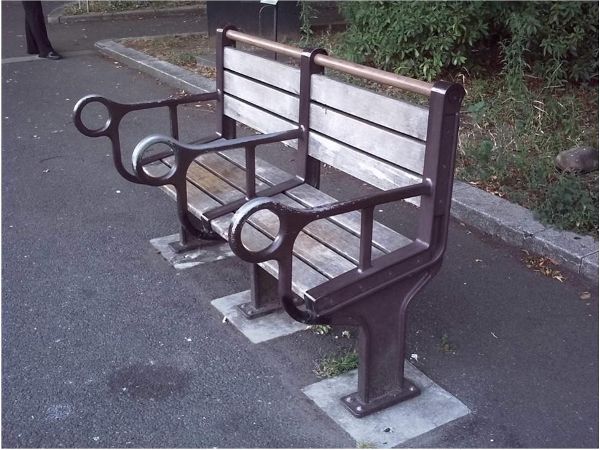
Figure 2. Park bench with armrest and seat incline, Tokyo, Japan. Photograph by the author.
Public-space bench designs can be made to play into any number of social agendas in addition to deterring the presence of the unhoused. For instance, take the bench in Tokyo’s Ueno Park shown in Figure 2. In an influential piece on antihomeless design in Japan, Yumiko Hayakawa claims that, in addition to featuring antisleep armrests, the slight slant of the seat of this bench is also designed to be slightly uncomfortable.[2] The goal is to discourage sitting too long and to encourage traffic flow through the park. Hayakawa reports that Ueno Park, the oldest public park in the entire country, is known to be a destination for unhoused sleepers. The bench designs in the park (and, in my observation, considering the park’s size, their striking overall scarcity) reflect the city’s effort to discourage the unhoused from taking up too much visible public space.
To capture these dynamics in which social forces intervene on the design of a technology to forward an agenda, we must turn to social theory.
Some of the most innovative and influential thinking on the philosophy of technology over the past three decades has been conducted in the field of science and technology studies (STS). Using sociological and anthropological methodologies, STS researchers investigate the ways that technologies are shaped by the rivalries that occur between social groups. As Nelly Oudshoorn and Trevor Pinch put it, “technological development emerges as a culturally contested zone where users, patient advocacy groups, consumer organizations, designers, producers, salespeople, policy makers, and intermediary groups create, negotiate, and give differing and sometimes conflicting forms, meanings, and uses to technologies.”[3]
Because these theories conceive of technologies as potentially adoptable by different social collectives, we can interpret them here to be roughly amenable to the phenomenological notion of multistability. It is my contention that by combining our account of multistability with the insights of STS theories of technology, we can develop an innovative and helpful scheme for articulating how social forces can come to close off or open up a technology’s various stabilities. This in turn will enable us to chart out the various social strategies involved in the design and experience of antihomeless technologies.
The particular STS account that I would like to consider here is Bruno Latour’s actor-network theory and specifically the way it pertains to everyday technologies or, as he calls them, “mundane artifacts.”[4] Under Latour’s view, when we account for the ways a group comes together to enact an agenda, we should consider not only the people who belong to that group but also the technologies that they enlist. The group, or “network” as it is called in this vocabulary, is made up of a variety of “actors,” and these actors can be either humans or “nonhumans,” such as technologies. Actor-network theory thus gives a social account of technology, one that understands what a device does in terms of its role in a social collective.
In this view, technologies are not neutral or innocent objects. They are active players within ongoing rivalries between networks. A network’s agenda, or “program of action,” as Latour calls it, is not reducible to the agency of some individual actor but emerges from the collective agency of the overall network. Under this view, a technology that has been enrolled into a network now becomes an active contributor to the network’s overall aims. But that same object could always be wrestled loose and counter-enlisted into a rival network.
To understand a technology’s role within a network, Latour provides a simple formula: “every time you want to know what a nonhuman does, simply imagine what other humans or other nonhumans would have to do were this nonhuman not present.”[5] We can conceive of a technology as adopting some of the competencies of the people whose work that device has been brought on board to perform. When we enlist a technology into a network to perform a particular job, we can be said to “delegate” that job to the device.
Latour clarifies these ideas with the description of another low-tech public-space device: the speed bump. From one point of view, a speed bump could be dismissed as a simple, neutral, inert lump in the ground. But from the perspective of actor-network theory, the speed bump is revealed to be the active site of a contestation between opposing networks. Imagine that you want to speed along a particular road. You could encounter a powerful network that wants you to slow down, one that includes the police department as well as the authority and resources of the state. This network has multiple options available. For instance, a police officer could be posted at the side of the road and assigned the task of issuing traffic citations to any drivers caught violating the speed limit. Or instead, in place of that officer, a speed bump can be built onto the road at that location, the task of the officer now delegated to this technology. (Latour notes that in some countries, a speed bump is referred to as a “sleeping police officer.”) In both cases, the speeding driver is compelled to comply. Otherwise, she faces either a speeding ticket or a damaged suspension.
To articulate these social and material dynamics, Latour borrows from Madeleine Akrich’s script theory. Under this account, as members of a collective play their parts in larger group agendas, they can be understood to follow social scripts. This is true not only for human actors but for technologies as well. As Akrich puts it, “like a film script, technical objects define a framework of action together with the actors and the space in which they are supposed to act.”[6] Following Akrich, we can use the term material inscriptions to refer to the modifications made to a technology to enroll it into a network and make it better follow that network’s social script. For example, in the case of the speed bump, we can imagine material inscriptions that could further embed this actor into the network and help it better perform its delegated task, such as adding striped paint to make it more visible to drivers or adding a sign at the side of the road to warn drivers of the bump.
The antisleep facets of public-space benches can be interpreted through the lens of this framework of concepts. Features of benches like armrests and seat partitions can be interpreted as material inscriptions. The larger social network that intends to discourage the unhoused from using public-space benches as beds inscribes this program of action into these devices themselves. The antisleep benches are thus enrolled into this network and delegated the task of dissuading people from sleeping in public in this manner.[7]
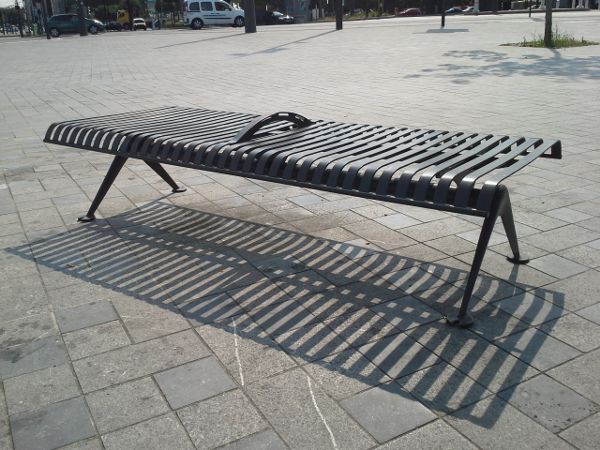
Figure 3a. An example of an antisleep bench: sidewalk bench in Paris. Photograph by the author.
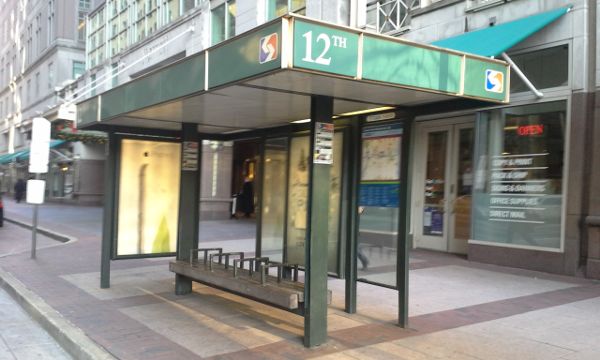
Figure 3b. An example of an antisleep bench: bus stop in Philadelphia, Pennsylvania, USA. Photograph by the author.
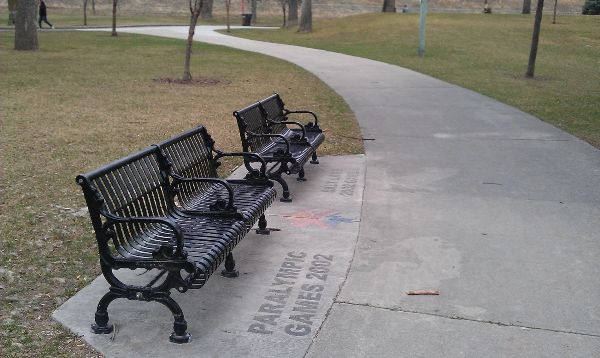
Figure 3c. An example of an antisleep bench: park bench in Salt Lake City, Utah, USA. Photograph by the author.
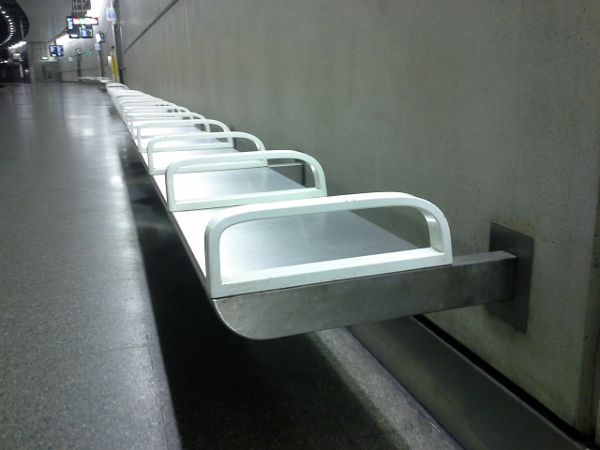
Figure 3d. An example of an antisleep bench: wall-mounted bench in the London Underground, England. Photograph by the author.
Despite all that the actor-network account accomplishes with regard to describing the dynamics of the antisleep bench, my suggestion is that even more could be achieved through including a phenomenological conception of multistability. I have two reasons for this suggestion. First, a conception of the multistability of technology helps to account for why particular networks come into conflict over particular devices in the first place. The actor-network perspective understands the agency of a technology in terms of its role in a network. But this perspective appears to lack an account of a technology’s readiness to participate in this or that particular action, and yet at the same time not just any action. The notion of multistability helps to fill this gap, and it does so because it is not an exclusively social concept but instead a philosophical conception of materiality. As a multistable material object, any technology is open to multiple uses and meanings and thus is open to enrollment in multiple networks.
The public-space bench is a case-in-point example. Actor-network theory is ideal for providing an account of the way the bench is altered as it is enrolled into one network and against another. But a notion of multistability is useful for accounting for what brought about this particular conflict over this device between these particular networks in the first place, namely, the bench’s peculiar material readiness to be used as a bed and the contingent preexisting need of some unhoused people for this alternative stability.
The second reason that I recommend a combination of the notion of multistability with the insights of actor-network theory is that it enables us to develop a useful categorization of the ways that social forces interact with a technology’s capacity to afford multiple uses.
Let’s consider three ways that social agendas can relate to the multistability of technology:
- 1. Restrictionary modifications: A network can move to “close off” a technology’s undesired stabilities. A multistable technology might offer more than one widely used stability, and a powerful social group may prefer to restrict the device in a way that renders it possible to use only through the group’s own preferred stability. Through material inscriptions, the technology can be modified so that it is difficult or impossible to use in terms of the undesired stability. The central example of this chapter, in which benches are redesigned to make them difficult or impossible to use as beds, is a paradigmatic example of a restrictionary modification.
- 2. Unrestrictionary modifications: In a case in which a restrictionary move has been made, and a stability of a technology has been closed off, a rival network may work to “reopen” that stability. Through its own counterinscriptive efforts, the rival network may attempt to lift those restrictions and reinstate the closed-off stability.
- 3. Expansionary modifications: Rather than closing off a stability, or reopening a formerly closed stability, it is possible to work to expand the ways that a technology could be used or to secure and enable multiple stabilities. Such modifications “open up” the possibilities for use.
This list is not exhaustive. For example, we could refine this breakdown further, even in its own terms. We could separate restrictionary modifications into at least two subcategories based on whether their restrictions come with more or less force. It is possible to distinguish between what could be called prohibitory modifications that attempt to make it impossible to utilize a device in terms of a particular stability and dissuasionary modifications that merely discourage that usage. We could consider a corresponding distinction that could be drawn within expansionary modifications. It may be possible at times to contrast facilitationary modifications that simply make a new stability available and what could be called persuasionary modifications that go further to actively encourage usage in terms of that new stability. Of course, there is a crucial context relativity to all of these categories. For example, what may be entirely prohibitory to one potential user may be merely dissuasionary to another user who possesses greater means to counter the work of that modification. It is surely possible to identify further refinements and even further classes of modification altogether. The point here is that the combination of a phenomenological conception of multistability with an actor-network account of material inscriptions makes this line of theorization possible.
In any case, in the analysis that follows, we will be guided mainly by the distinctions between restrictionary, unrestrictionary, and expansionary modifications. That is, we will focus on design strategies that close off, reopen, and open up the possible ways that users may take up their devices. These notions will help us address the various ways that multistable public-space technologies are subject to the tug-of-war of social and political forces. They will also help us to articulate the particular ways that antihomeless designs fit into larger political agendas—and how things could be otherwise.
Interlude: Spikes
In June 2014, a picture was posted to the social media website Twitter of a set of chrome spikes built into the ground in an alcove outside a London apartment building.[8] As noted in the tweet, the unmistakable intention behind this design feature was to prevent people from using the area as a place to sleep. The tweet went viral and was shared across the Internet, inciting outraged responses. Activists identified other instances of antihomeless spikes, including some elsewhere in London installed along a ledge outside a Tesco supermarket and some on the other side of the ocean outside a bookstore in downtown Montreal. An online petition was established that immediately accrued tens of thousands of signatures. Then mayor of London Boris Johnson joined in, tweeting, “Spikes outside Southwark housing development to deter rough sleeping are ugly, self defeating & stupid. Developer should remove them ASAP.”[9] The mayor of Montreal similarly hopped aboard, tweeting, “The anti-homeless spikes are unacceptable!!!”[10] Protesters snapped pictures of themselves lying down beside the spikes. Others vandalized the spikes, covering them with concrete.
By the time the petition had cleared 130,000 signatures, the spikes were removed from the apartment building, the bookstore, and the supermarket.
Of course what makes the spikes a special case is their unhidden nature. They do not merely make it difficult or impossible to sit or sleep wherever they have been installed. They also communicate in stark terms the message that unhoused people are not welcome. Those who take notice of antihomeless spikes are often struck by their similarity in design and strategy to those smaller versions mounted to signs and rooftops to shoo away pigeons. This ready comparison leads many to conclude that such spikes are inhumane, indeed almost identical to the treatment of pests.
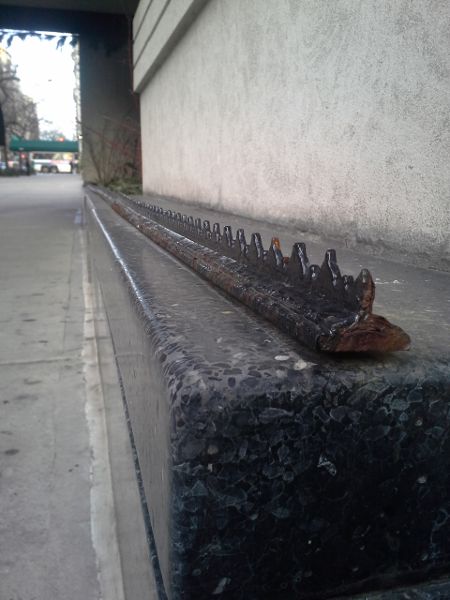
Figure 4a. A wrought iron spike-studded strip set across a ledge in New York City, New York, USA. Photograph by the author.
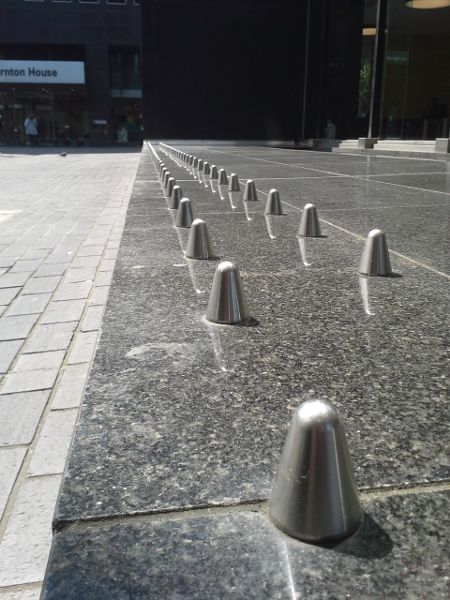
Figure 4b. A ledge set with chrome spikes in London, England. Photograph by the author.
Although the preceding story recounts a recent small victory in the struggle against antihomeless sentiment built into the urban environment, spikes and similar studs remain an utterly commonplace fixture of many urban spaces.[11] They can be found across any number of surfaces and ledges, sometimes built into the ground and sometimes under bridges and overpasses in the form of boulders, concrete pyramids, and cobblestone.[12]
My suggestion is that the case of antihomeless spikes presents us with a test of our moral intuitions. Because of their unmasked nature, and because of the visible outrage they have sparked, they present us with questions. We are prompted to ask ourselves if we share in the outrage over these actions against unhoused people. Does the use of spikes strike you as an immoral or unjust way for human beings to be treated? If so, then I suggest that this outrage commits you to similar moral discomfort with a variety of other antihomeless laws and designs. The spikes represent only the most brazen and least hidden edge of the larger and more pervasive effort in design and policy that targets the unhoused. The spikes are, so to speak, the pointy tip of the iceberg.
Whereas the spikes telegraph their intentions loudly and unmistakably, the antisleep bench is different. A design like the antisleep bench instead shuts down usage as a place to sleep while at the same time enabling usage as a place to sit, all without similarly broadcasting these dynamics. One could sit on the bench and remain unaware of its antisleep design. That is, one could easily spend time sitting on an antisleep bench without having any idea about its simultaneous role in denying unhoused people this particular site as a place to sleep and, generally, in contributing to a larger effort to flush the unhoused out of public space. Whether we consider the spikes, the benches, or the further designs and laws to be discussed in the following chapters, the effects are the same. The spikes are simply the most forthcoming about their intentions.
Thus, if your moral reasoning and intuition bring you to recognize that designs like the antihomeless spikes are no way to treat fellow citizens and fellow human beings, then it turns out that you also hold an additional moral position: you should be additionally against the larger and less visible panoply of laws and designs that target the unhoused. And, incidentally, so should the mayors of London and Montreal.